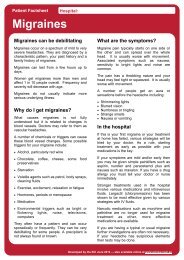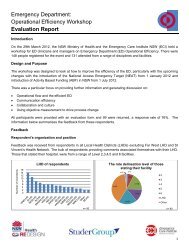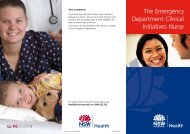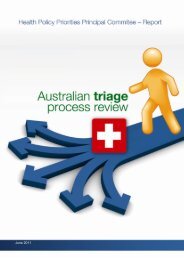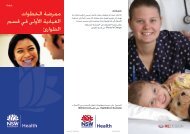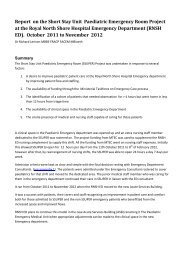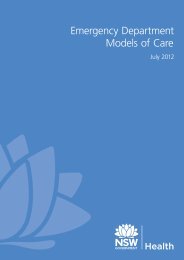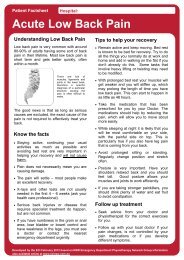Facilitators Manual - Emergency Care Institute
Facilitators Manual - Emergency Care Institute
Facilitators Manual - Emergency Care Institute
Create successful ePaper yourself
Turn your PDF publications into a flip-book with our unique Google optimized e-Paper software.
ACTIVITY 32Complete the following table, providing a brief outline of the classifications of shock (eg septic) andthe underlying pathophysiology, and give examples for each category.Classifications of shockSepticSpinalHypovolaemicObstructiveCardiogenicAnaphylacticUnderlying pathophysiologySeptic shock is defined by the manifestation of hypotension with evidence of infection.Decreased or no change in cardiac output, decreased systemic vascular resistance, Decreasedcapillary resistance, pulmonary capillary pressure and increased pulmonary vascular resistance.Decreased cardiac output, increased systemic vascular resistance, decreased capillarycirculation and pulmonary capillary pressure, increased pulmonary vascular resistance.Decreased cardiac output, systemic vascular resistance and capillary function, increasedpulmonary capillary pressure and pulmonary vascular resistance.Decreased cardiac output and capillary circulation, increased systemic vascular resistance,pulmonary capillary pressure and pulmonary vascular resistance.Decreased cardiac output, systemic vascular resistance, capillary circulation, pulmonarycapillary pressure and pulmonary vascular resistance.Table adapted from ACCCN’s Critical <strong>Care</strong> Nursing (Elliott, Aitken, Chaboyer (eds) 2007, Mosby, Australia) – Chapter 15, page 445Table 15.5 ‘Physiological changes in shock’.19ACTIVITY 33What are the differences in patient symptoms in systemic inflammatory response syndrome (SIRS),sepsis, severe sepsis and septic shock?TypeSystemicinflammatoryresponse syndrome(SIRS)SepsisSevere sepsisSeptic shockSymptomsA non specific syndrome that occurs as a result of a wide variety of severe clinical insults,and manifests in 2 or more of the following conditions:• Temperature>38 or 90 beats/min.• Respiratory rate >20 breaths/min or PaCo 2 12 000/mm¬¬3 or 10% immature band (forms).• Patients may present with tachycardia, tachypnoea, hyperpnoea, hypotension, hypoperfusion,oliguria, leucocytocis or leucopenia, pyrexia or hypothermia. Patients may have metabolicacidosis, dry mucous membranes.• Systemic inflammatory response to infection. Similar presentations as those in SIRS.• Sepsis associated with organ dysfunction, hypoperfusion, or hypotension. Symptoms mayinclude alteration in neurological status, and hypoperfusion abnormalities including oliguria.• Absence of other hypotension, despite adequate fluid resuscitation, along with the presenceof perfusion abnormalities that may include but are not limited to lactic acidosis, oliguria, oracute alteration in neurological status.• Acute circulatory failure with persistent arterial hypotension unexplained by other causesand despite adequate fluid resuscitation.Table adapted from ACCCN’s Critical <strong>Care</strong> Nursing (Elliott, Aitken, Chaboyer (eds) 2007, Mosby, Australia) – Chapter 15, page 445Table 15.5 ‘Physiological changes in shock’.ACTIVITY 34Read the following management guidelines on acute coronary syndrome and discuss with yourfacilitator or support person:http://www.heartfoundation.org.au/SiteCollectionDocuments/acs%20guidelines%20mja%20summary.pdf’Guidelines for the management of acute coronary syndromes 2006‘ 17/04/06 MJA supplement vol 184no 8 http://www.mja.com.au/public/issues/184_08_170406/suppl_170406_fm.html accessed throughwww.mja.com.au




